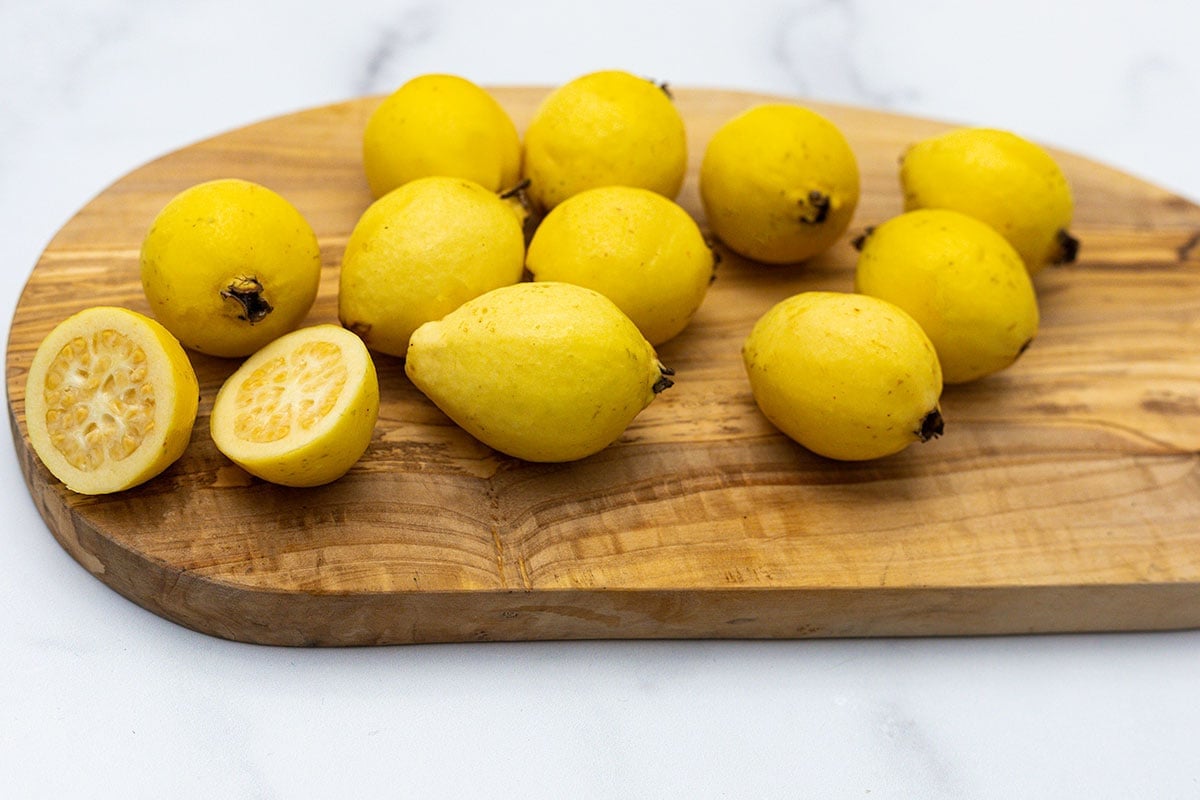Yellow Guava
Let’s not forget is succulent juice that is packed with a high amount and a good source of nutrients, minerals, and compounds. Though not as popular as pink or white guava, yellow guava is still a good snack to have.
What Is Yellow Guava?
Yellow guava or yellow strawberry guava has a smooth yellow skin with a light-yellow pulp with edible seeds. The fruit is a part of the genus- Psidium and a part of the Myrtaceae family.
Its tree grows up to 25ft but varies in size with frilly white flowers. The fruit is one of the smallest in size, of the guava species but has a nice and flavourful sweet yet lemony taste.
Yellow Guava Leaves
The leaves from the tree can be used in the form of a tea or herbal tea. Picking fresh leaves (2-3) then washing them properly, place them in a pot of boiling water (4 cups) for approximately 5 minutes and cover it. Strain the liquid then pour into a ta cup/mug then sweeten to your liking with either honey or sugar.

Yellow Guava VS White Guava
Yellow guavas (Psidium cattleianum littorale) are much smaller in size than White Guavas. It carries a more oval shape with the sweetness of a lemony flavor, unlike white guava that is packed with higher levels of Vitamin C, sweet and less water content.
Another comparison is that white guava pulps are creamy-white with a green-yellow smooth exterior. While yellow guavas have a light-yellow pulp with yellow smooth exterior skin that is seedier.

How To Eat Yellow Guava?
The following are a few popular methodologies on how to consume yellow guava fruit:
- The fruit is just so delightful that many eat it raw and even sometimes with the skin. By washing the fruit carefully, you can eat the whole thing! Because even the rind has more Vitamin C than an orange. Within a few bites, it gone that makes room for another one, and boom! See how quickly you can get addicted? The small size packed with juicy goodness will do that to you.
- First, wash the fruit then slice it into two or three wedges. You can also choose to peel off the yellow skin with a knife before slicing then Bon Appetit!
- Yellow guava can be incorporated in dishes or baked products, even pastes! The sweet yet lemony flavor would especially be nice in making yellow guava jam, pies, smoothies, and juices. Let’s not forget a good glaze for shrimp or jam.

How To Store Yellow Guava?
Slice the fruit into wedges then store them in a zipper resealable bag or container. Store in your refrigerator (crisper) and it will keep for up to 4 days but when stored in the freezer it can last up to approximately 5 months.
You know that little slogan- reuse, reduce and recycle!? Well, you can be resourceful with the fruit’s seeds. Store the seeds in a clear bag after drying and keep in a cool area until its ready to be used.
How To Grow A Guava Plant From The Seed?
You can either boil the seeds for 4-5 minutes or soak the seeds in water-two weeks before planting. These two methods activate the dormant seeds for germination to occur.
Where To Buy Guava?
Though it’s not as popular as the other types of guava, you can purchase yellow guava at your farmer’s market and supermarkets.
Health Benefits Of Yellow Guava
This little oval-shaped fruit is like a pocket of a nutrient booster. In Jamaica, they say ‘wi lickle but wi talawah’ meaning though small in size we are strong and powerful. That’s what yellow guava reminds me of. These are some benefits:
- Regulates blood sugar levels.
- Regulates blood pressure.
- May improve vision.
- Assists indigestion, constipation, and diarrhea.
- Helps in wound healing.
- May improve nerve and brain functionality.
- Repair tissues and cells.
- Strengthen muscles, bones, and teeth.
- Prevents and treats scurvy (due to high Vitamin C levels)
- Improve and maintain the immune system.
- May improve skin- giving a healthier glow.
- May assist in weight loss.
- Mood stabilizer.
- Prevents urolithiasis.
- Assist with preventing anemia.
The above is not limited to the benefits of yellow guava; however, the following nutrients, minerals, and compounds are present in the fruit: Vitamin A, Vitamin B6, Vitamin C, Vitamin E, Vitamin K, potassium, manganese, magnesium, phosphorus, iron, folate, fiber, pectin, copper, calcium and zinc. Read More 1, 2, 3, 4, 5,
Uses For Yellow Guava
The fruit and its leaves are used for:
- Skincare
- Haircare
- Dishes/meals e.g jams
- Detoxifier
- Healthcare
- Extracted oil
Side Effects
Eating too much of something will have its cons, thus, persons suffering from diabetics are instructed to pay attention to their intake or consumption of guava overall. This is because it can drop blood sugar levels too low. Whereas other negative reactions are skin irritation, nausea, and stomach pain.
We hope this article was helpful to you to learn more about yellow guava. As I love to say Bon Appetit!

Other Amazing Fruits To Read About
- Tuna Fruit
- Florida Pomelo
- Naseberry/Sapodilla
- Papaya
- Loquat Fruit
- Ground Cherries
- Key Lime
- Seville Orange
- Guinep
- Golden Kiwi
- Egg Fruit
- Black Sapote
If you enjoyed this post and would love to see more, join me on Youtube, Instagram, Facebook & Twitter!
Join Our Facebook Juice Support Group
Love seasonal recipes? Don’t miss out on my special offer for a limited time! Grab all three of my cookbooks for just $19.99! They’re filled with delicious, healthy dishes that are perfect for every season. Hurry and get your set before the offer ends!







Is the yellow guava found in Jamaica
Yes it is in Jamaica